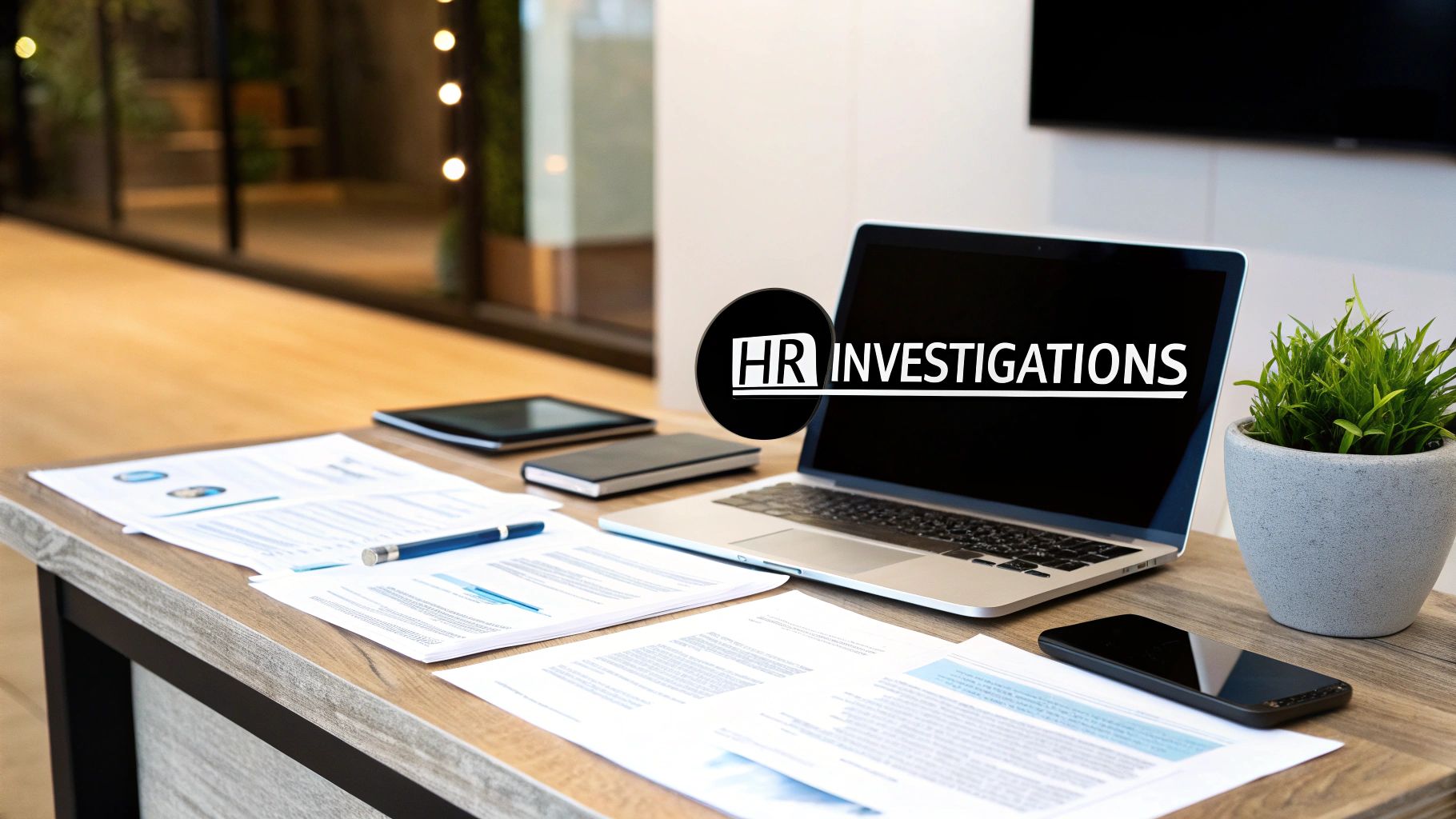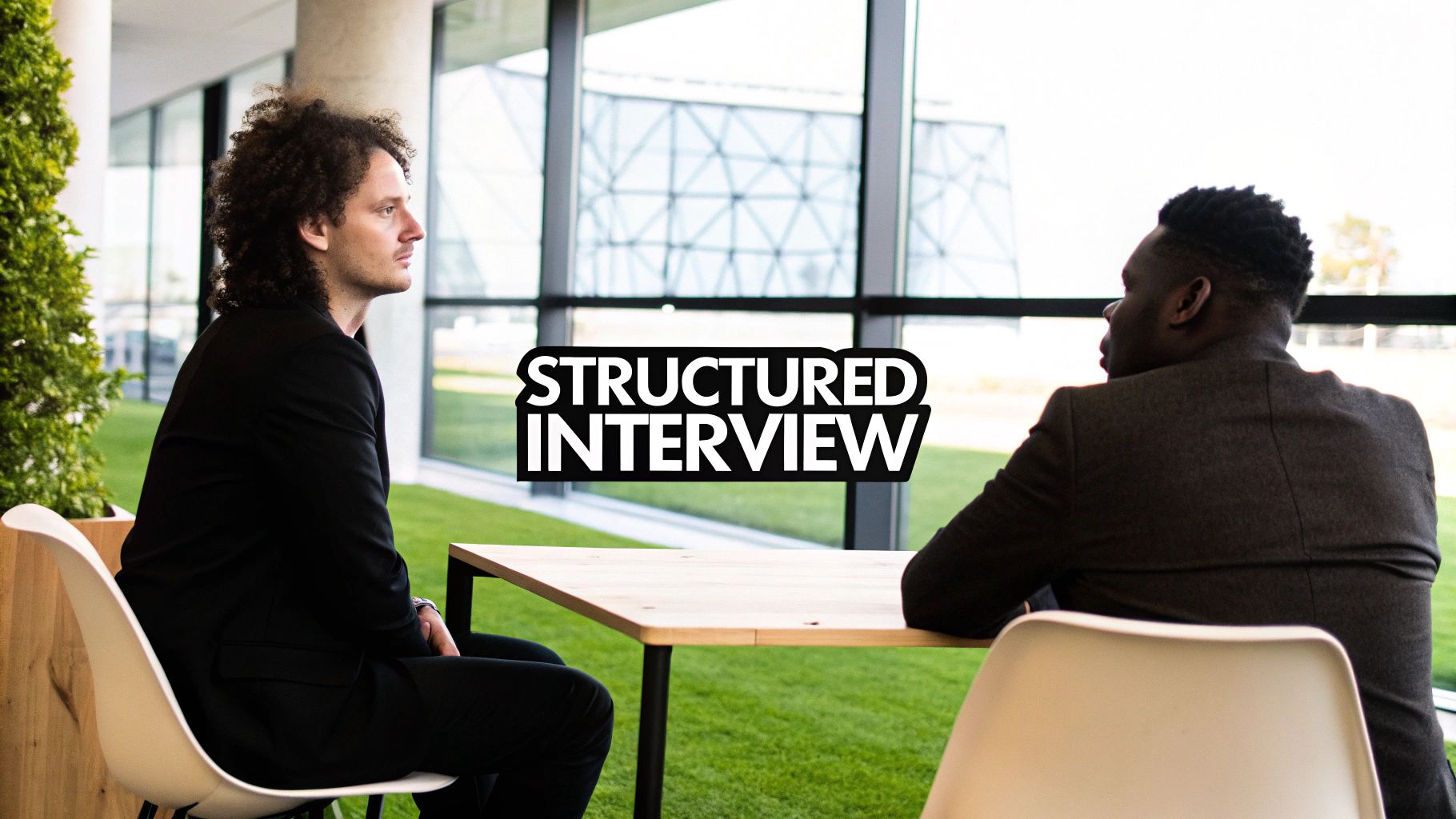Mastering The Fundamentals of HR Investigations

A robust HR investigation process forms the bedrock of a fair and productive workplace. It ensures that employee concerns are addressed thoroughly and objectively, protecting both individuals and the organization as a whole. This section explores the foundational principles that underpin effective HR investigations, empowering you to create a more harmonious and just work environment.
The Principles of Fairness, Confidentiality, and Thoroughness
Effective HR investigations rest on three core principles: fairness, confidentiality, and thoroughness. Fairness dictates that all parties involved are treated impartially, with equal opportunities to share their perspectives.
Confidentiality protects sensitive information disclosed during the investigation. This fosters trust and encourages open communication, vital for uncovering the truth.
Thoroughness guarantees that all relevant information is gathered and analyzed objectively before any conclusions are drawn. These elements work in concert to build an investigation process that is both credible and legally sound.
The increasing prevalence of workplace investigations underscores the growing importance of these principles. In recent years, there has been a notable rise in workplace investigations globally, largely due to heightened awareness of workplace culture and issues like bullying, harassment, and discrimination. This trend is further explored in this insightful article: Worldwide Increase in Workplace Investigations. This surge highlights the critical need for HR professionals to develop expertise in conducting effective investigations.
Tailoring Investigations to Specific Workplace Issues
Every workplace situation is unique. This requires an adaptable HR investigation process that can effectively address a wide spectrum of issues.
For instance, investigating a policy violation necessitates a different approach than investigating allegations of harassment. Understanding these nuances is essential for collecting relevant evidence and reaching well-founded conclusions. By tailoring the investigation to the specific circumstances, HR ensures the process remains focused and yields meaningful results.
Reactive Vs. Proactive Investigations: Unveiling Systemic Issues
While reactive investigations are essential for addressing immediate concerns, they often reveal underlying systemic problems. These may include inadequate policies, insufficient training, or a toxic work environment.
By delving into the root causes of workplace conflicts, HR can implement proactive measures to prevent similar issues from recurring. This proactive approach transforms HR investigations from a reactive measure into a powerful tool for organizational growth and positive change.
Embracing proactive investigation strategies demonstrates a commitment to cultivating a healthier and more productive workplace. It ensures that investigations not only resolve existing conflicts but also contribute to lasting improvements in workplace culture.
The Proven Roadmap for Effective HR Investigations

Beyond simply establishing a foundation of principles, a well-defined HR investigation process is critical for achieving consistent and trustworthy outcomes. This structured approach minimizes disruptions within the organization, while ensuring every concern is addressed thoroughly and respectfully. Let's explore the essential stages of an effective HR investigation process.
Initial Intake and Assessment
The journey begins with a comprehensive intake process. This involves meticulous documentation of the initial complaint and gathering preliminary information to understand the situation fully. This stage focuses on understanding the nature of the complaint, identifying all individuals involved, and determining the scope of the necessary investigation.
For instance, a complaint regarding inappropriate language will require a different investigative approach than one alleging discrimination. Effective intake sets the tone for the entire investigation, ensuring all pertinent details are captured from the very beginning. This careful documentation builds a solid foundation for all subsequent steps.
Developing The Investigation Plan
With a firm grasp of the initial complaint, the next step is to develop a structured investigation plan. This plan serves as the roadmap, outlining the crucial steps for gathering evidence, conducting interviews, and analyzing all collected information.
Like a detective meticulously piecing together a case, this stage involves identifying potential witnesses, gathering relevant documents, and establishing a realistic timeline for completing the investigation. A well-defined plan maintains focus and efficiency, keeping the investigation on track and minimizing the risk of overlooking critical information or experiencing unnecessary delays.
Conducting Thorough Interviews
Interviews are the cornerstone of any HR investigation. They offer the opportunity to gather firsthand accounts from everyone involved: the complainant, the accused, and any witnesses. Effective interviewing techniques are vital for uncovering essential details and diverse perspectives.
Using open-ended questions, for example, encourages individuals to share their experiences completely. Creating a safe, neutral environment helps put participants at ease. This fosters open communication, which allows for the gathering of accurate and comprehensive information, enabling a more objective understanding of the situation.
Evidence Evaluation and Conclusion
After conducting interviews and gathering all relevant documents, the next step is to carefully evaluate the evidence. This requires objectively analyzing all gathered information, considering the credibility of witnesses, and identifying any patterns or inconsistencies.
This process demands critical thinking and meticulous attention to detail. Like assembling a complex puzzle, each piece of evidence contributes to a clearer picture of the situation. Based on this thorough analysis, the investigator then reaches a conclusion regarding the validity of the complaint. This conclusion forms the bedrock for appropriate action.
To further clarify the HR investigation process, the following table provides a step-by-step overview:
HR Investigation Process Steps Overview
A comprehensive breakdown of the key steps in a standard HR investigation process with associated timeframes and key activities
| Investigation Step | Typical Timeframe | Key Activities | Best Practices |
|---|---|---|---|
| Initial Intake and Assessment | 1-3 days | Documenting the complaint, gathering initial information, identifying involved parties | Ensure clear documentation, maintain confidentiality, provide prompt acknowledgement to the complainant |
| Developing the Investigation Plan | 2-5 days | Creating a structured plan, identifying witnesses, gathering relevant documents | Establish a realistic timeline, prioritize key tasks, maintain objectivity |
| Conducting Thorough Interviews | 5-10 days | Interviewing the complainant, accused, and witnesses, gathering firsthand accounts | Use open-ended questions, create a safe environment, document all interviews thoroughly |
| Evidence Evaluation and Conclusion | 3-7 days | Analyzing gathered information, assessing witness credibility, identifying patterns and inconsistencies | Maintain objectivity, consider all perspectives, document the rationale behind the conclusion |
| Implementing Appropriate Actions and Follow-Up | Ongoing | Implementing disciplinary action, policy changes, or training, monitoring for retaliation | Communicate decisions clearly, ensure consistent follow-up, document all actions taken |
This table provides a structured overview of the typical timeframe and key activities involved in each step of the HR investigation process. The best practices highlighted ensure a fair and efficient investigation.
Implementing Appropriate Actions and Follow-Up
The final stage involves implementing the appropriate actions based on the investigation's findings. These actions can range from disciplinary measures to policy changes or additional training. Critically, the process doesn't end there.
Consistent follow-up is paramount. Checking in with involved parties ensures actions are implemented effectively and helps to identify any potential retaliation. This proactive follow-up demonstrates a genuine commitment to fairness. By implementing appropriate actions and following up consistently, organizations cultivate a workplace built on trust, respect, and accountability, ultimately fostering a safer and more productive environment for all.
Navigating Legal Landmines in the HR Investigation Process

Every HR investigation requires careful navigation of a complex legal landscape. Understanding these legal considerations is essential for fair and legally sound outcomes. This section explores how successful organizations address these complexities, ensuring legal concerns don't hinder the investigative process.
Understanding Key Compliance Requirements
Employment law significantly shapes how HR investigations unfold, from initial documentation to final resolution. Laws regarding employee privacy, discrimination, and whistleblowing influence how information is gathered, handled, and used.
Ignoring these requirements can expose organizations to significant liability. This makes legal awareness a cornerstone of a robust HR investigation process.
Procedural Fairness and Confidentiality
Maintaining procedural fairness is crucial. This ensures all parties are treated impartially and have a fair chance to share their perspective. Simultaneously, confidentiality protects individual privacy and fosters open communication.
Balancing these two can be challenging, particularly in sensitive cases. It requires thoughtful consideration and a commitment to both fairness and discretion.
Minimizing Liability Exposure
A legally sound HR investigation aims to minimize liability. Meticulous documentation of every step is vital, ensuring all actions are justifiable and comply with legal requirements. Organizations must also be ready to defend their processes and decisions if challenged.
Maintaining defensible records is not merely a best practice; it’s a critical shield against potential legal issues. The rise in workplace investigations is further influenced by regulatory changes like strengthened whistleblowing laws, empowering employees to report misconduct without fear of reprisal. Learn more about these trends.
The Role of Legal Counsel
Knowing when to involve legal counsel is paramount. Early legal advice can prevent costly missteps and ensure compliance. Counsel can offer guidance on specific obligations, assist with document review, and represent the organization in legal proceedings if needed.
This makes legal counsel an invaluable partner in navigating workplace investigations. Their expertise provides clarity and support, allowing HR to conduct thorough and legally sound investigations.
Handling Conflicting Legal Obligations
HR investigations can sometimes encounter conflicting legal obligations. The duty to protect employee confidentiality may, for instance, conflict with the need to disclose information during legal discovery.
Successfully addressing these situations demands careful review of all legal requirements and, when necessary, seeking expert legal guidance. This ensures the investigation remains legally sound while upholding ethical responsibilities.
Overcoming Common HR Investigation Roadblocks

Even with a robust HR investigation process in place, roadblocks can still appear. These obstacles can potentially jeopardize the entire investigation, making it vital for HR professionals to understand and proactively address these challenges. This section explores practical strategies for navigating these common obstacles and ensuring a fair and just process for all involved.
Reluctant Witnesses And Fear of Retaliation
One of the most common hurdles in HR investigations is the reluctance of witnesses to come forward. This hesitation often stems from a fear of retaliation, particularly in cases involving senior leaders. Building a culture of trust and confidentiality is paramount.
Assuring witnesses of anonymity where possible is a critical first step. Emphasizing the organization's unwavering commitment to protecting those who speak up is equally essential. Clear anti-retaliation policies, coupled with consistent enforcement, are key to encouraging open communication and cooperation.
Investigations Involving Senior Leaders
Investigations involving individuals in leadership positions present unique difficulties. Maintaining impartiality can be a significant challenge, and the risk of perceived or actual conflicts of interest is elevated. How can you ensure fairness and maintain trust?
Engaging external investigators can be an invaluable strategy. This outside perspective brings objectivity and credibility to the process, fostering confidence in the investigation's findings. This approach can also alleviate internal pressures and concerns about bias.
Maintaining Confidentiality
Confidentiality is the cornerstone of any HR investigation. However, maintaining discretion can be particularly challenging in close-knit work environments. Rumors and speculation can spread rapidly, potentially undermining the investigation's integrity. Workplace issues are on the rise, with a five-year high in reported volumes according to HR Acuity's research.
Reinforcing the importance of confidentiality with everyone involved is essential. Regularly communicating updates through appropriate channels helps control the flow of information and minimize speculation. This measured approach protects the integrity of the ongoing investigation and maintains a respectful environment.
Evaluating Contradictory Accounts
HR investigations frequently involve conflicting accounts of events. Investigators must act as impartial arbiters, carefully analyzing evidence and assessing witness credibility. This careful evaluation is crucial for determining the most probable sequence of events.
Developing strong analytical skills is essential for navigating these complexities. Employing a structured approach to evidence evaluation helps ensure a thorough and unbiased assessment of contradictory statements and evidence.
Preserving Digital Evidence
In today’s digital age, electronic evidence such as emails, text messages, and social media posts can provide crucial insights. This digital footprint can be invaluable in uncovering the truth.
However, this type of evidence can be easily lost or deleted, either intentionally or unintentionally. Implementing swift and decisive measures to preserve digital evidence is vital for ensuring a comprehensive and accurate investigation.
Managing The Emotional Aspects
HR investigations often delve into sensitive and emotionally charged situations. Investigators must effectively manage both their own emotions and those of the involved parties.
This delicate balancing act requires demonstrating empathy and sensitivity while remaining objective and focused on gathering the facts. This compassionate yet impartial approach fosters a respectful and productive environment while pursuing the truth.
Working With Limited Resources
Many HR departments face the challenge of conducting investigations with limited resources. This can create significant obstacles to a thorough and timely process.
Prioritizing tasks, setting realistic timelines, and focusing on the most critical aspects of the investigation can help overcome these constraints. A well-defined process and clear communication ensure effectiveness even with limited resources.
The table below offers further guidance on navigating common HR investigation challenges. It outlines the potential impact of each challenge and offers practical solutions and preventative strategies.
Common HR Investigation Challenges and Solutions
| Challenge | Impact on Investigation | Recommended Solution | Prevention Strategy |
|---|---|---|---|
| Reluctant Witnesses/Fear of Retaliation | Incomplete information, skewed findings | Anonymous reporting mechanisms, strong anti-retaliation policies | Regularly communicate anti-retaliation policies, build a culture of trust |
| Investigations Involving Senior Leaders | Perceived bias, conflict of interest | Engage external investigators | Establish clear protocols for investigations involving senior leaders |
| Maintaining Confidentiality | Compromised investigation integrity, damaged reputations | Clear communication protocols, strict confidentiality agreements | Reinforce confidentiality expectations with all parties involved |
| Evaluating Contradictory Accounts | Difficulty determining facts, potential for misinterpretation | Structured evidence analysis, witness credibility assessment techniques | Detailed documentation of all interviews and evidence collected |
| Preserving Digital Evidence | Loss of crucial information, incomplete picture of events | Swift implementation of data preservation measures | Establish clear protocols for digital evidence preservation |
| Managing Emotional Aspects | Compromised objectivity, escalation of conflict | Training in emotional intelligence and conflict resolution | Provide resources and support for investigators dealing with sensitive situations |
| Working with Limited Resources | Delayed investigations, insufficient depth of inquiry | Prioritization of tasks, realistic timelines | Invest in HR technology and resources, develop streamlined processes |
By understanding these common challenges and implementing the recommended solutions, HR professionals can conduct effective investigations, uphold fairness, and foster a positive workplace environment. Remember, a well-handled investigation strengthens trust and reinforces the organization's commitment to its employees.
Developing Critical HR Investigation Skills That Get Results
A well-defined HR investigation process is crucial. But it's the human touch, the investigator's skill, that truly unlocks its potential. This section explores the essential skills that set exceptional HR investigators apart. These specialized skills are your guide through the complexities of workplace dynamics, helping you reach fair and defensible conclusions.
Mastering Interviewing Techniques
Effective interviewing forms the bedrock of any HR investigation. It's more than just asking questions; it's about fostering a safe space where individuals feel comfortable sharing sensitive information.
This involves building rapport and actively listening. It also means employing specific techniques like the funnel technique. This approach begins with broad, open-ended questions and progressively narrows the focus toward specific details. This encourages thorough disclosure while maintaining a respectful and supportive environment. For example, instead of asking "Were you harassed?", an investigator might ask "Can you describe the interactions you had with this individual?". This empowers the interviewee to share their story without feeling pressured to use specific legal terminology.
Objective Evidence Analysis: Developing a Critical Eye
Gathering information is just the first step. Analyzing it objectively is equally vital. HR investigators must be able to discern truth from conflicting accounts, evaluate the credibility of witnesses, and recognize patterns within the evidence.
This requires cultivating sharp analytical skills and using a structured framework for evidence evaluation. Imagine assembling a jigsaw puzzle: Each piece of evidence – a document, an interview transcript, or a digital communication – contributes to a clearer picture. This meticulous approach allows investigators to draw well-founded conclusions based on a complete understanding of the facts.
Documentation Best Practices: Creating a Clear Record
Meticulous documentation is paramount throughout the HR investigation process. A clear record not only substantiates the investigation's findings but also safeguards the organization should decisions be challenged. Documentation should be objective, factual, and free from subjective interpretations or personal opinions.
This means documenting every step, from the initial complaint to the final resolution. Maintaining easily accessible and organized files streamlines the process and promotes transparency. Thorough documentation also ensures compliance with employment laws, creating a legally sound record of the investigation.
Managing Bias and Maintaining Professional Boundaries
HR investigations often involve colleagues, requiring investigators to uphold professional boundaries and manage personal biases. We all have preconceived notions, but acknowledging and mitigating these biases is crucial for conducting an impartial investigation.
This involves self-awareness, thoughtful reflection, and a conscious effort to consider all perspectives. Maintaining professional distance keeps the investigation focused on the facts, not personal relationships or office politics. Even if the investigator has a personal connection with someone involved, impartiality is paramount.
Emotional Intelligence in HR Investigations
HR investigations often deal with emotionally charged situations. Investigators need high emotional intelligence to manage their own emotions and those of the individuals involved. This enables them to navigate sensitive conversations with empathy and maintain a calm and productive atmosphere, even when addressing difficult or distressing subjects.
This ability to show empathy while remaining objective builds trust with all participants and facilitates the collection of accurate information. Emotional intelligence can de-escalate tense situations and foster a more cooperative environment, resulting in more productive and insightful investigations. Just as a therapist creates a safe space for patients, a skilled HR investigator fosters an environment where individuals feel heard and understood, even during challenging discussions. By honing these key skills, HR professionals conducting investigations can significantly contribute to a more fair, respectful, and legally compliant workplace. This, in turn, cultivates trust and strengthens the entire organization.
Leveraging Technology In The HR Investigation Process
Technology is transforming HR investigations, empowering organizations to conduct them with greater efficiency, consistency, and defensibility. Digital tools are proving invaluable for enhancing investigation quality while minimizing administrative overhead. Let's explore how these technologies are reshaping HR investigations.
Case Management Systems: Streamlining Workflows and Ensuring Consistency
Case management systems offer a centralized hub for managing each step of the HR investigation process. These systems provide standardized templates for documentation, automated notifications for stakeholders, and secure storage for sensitive information. This structured approach ensures consistency across all investigations, irrespective of the investigator.
Furthermore, these systems automatically create audit trails, offering a comprehensive record of every action taken. This strengthens defensibility. Should a legal challenge arise, the audit trail provides easily accessible documentation of the process followed.
Secure Digital Platforms: Facilitating Evidence Collection and Maintaining Confidentiality
Secure digital platforms streamline evidence collection while upholding confidentiality. These platforms offer a safe and secure environment for storing interviews, documents, and other sensitive information. This centralized repository simplifies access for authorized personnel while guarding against unauthorized disclosures.
For instance, investigators can securely upload interview recordings and share them with legal counsel, maintaining confidentiality throughout. These platforms can also integrate with eDiscovery tools like Everlaw for even greater efficiency.
Data Analytics: Identifying Patterns and Proactive Intervention
Data analytics tools are becoming essential resources in HR investigations. By analyzing data from multiple investigations, HR can identify trends and patterns related to workplace issues. This aggregated data can uncover systemic problems requiring broader intervention, such as tailored training programs or policy adjustments.
For example, if data analysis reveals a recurring pattern of harassment within a specific department, HR can implement targeted training to address underlying cultural contributors. This proactive approach helps prevent similar issues from reoccurring.
Practical Implementation Strategies: Enhancing Human Judgment, Not Replacing It
Successfully integrating technology demands a thoughtful approach. The aim is to augment human judgment, not replace it. Technology should be a tool that empowers investigators, not dictates their actions.
Even with limited technical resources, organizations can start by incorporating basic digital tools, such as secure file-sharing platforms like ShareFile. This gradual adoption allows HR to adapt to new technologies incrementally and optimize their impact. Training on the effective use of these technologies is also paramount. Just as any skilled professional requires training with new tools, so too do HR professionals need guidance to fully leverage investigative technologies. Through mindful integration, HR can cultivate an investigation process that is both efficient and legally sound, ensuring fairness and promoting a respectful workplace.
Turning Investigation Insights Into Organizational Growth
The true value of the HR investigation process goes beyond simply resolving individual cases. Forward-thinking organizations understand that the results of these investigations offer a wealth of knowledge that can drive significant organizational improvement. This section explores how to transform these insights into positive change, creating workplaces where serious issues are less likely to occur.
Communicating Findings and Providing Closure
Communicating investigation findings requires a delicate balance: providing necessary closure while maintaining confidentiality. Transparency is essential, but it must be handled with care. Sharing specific details with those not directly involved can breach privacy and damage trust.
Instead, focus on communicating the outcome and the steps taken to address the situation. This approach offers closure without compromising confidentiality. For example, rather than disclosing specifics about a harassment case, HR could communicate that, "The investigation is complete, appropriate action has been taken, and we are implementing additional training to prevent similar situations."
Implementing Corrective Actions: Addressing Root Causes
Truly effective corrective actions do more than just treat the symptoms; they target the root causes. If an investigation uncovers a pattern of bullying stemming from unclear performance expectations, the solution isn't just to discipline the bully.
The organization must clarify performance standards, provide training on appropriate workplace conduct, and create clear reporting procedures. This approach addresses the core issue, leading to lasting change. Much like a doctor treating the underlying illness rather than just the symptoms, HR investigations should result in solutions that prevent recurrences.
Monitoring For Retaliation: Protecting Witnesses and Complainants
Monitoring for potential retaliation after an investigation is critical. Retaliation can take many forms, from subtle exclusion to outright demotion or termination. It not only harms the individual targeted but also discourages others from reporting future misconduct.
HR should implement clear anti-retaliation policies and actively monitor the workplace after an investigation concludes. Regular check-ins with complainants and witnesses can help to quickly identify and address any retaliation. This proactive approach demonstrates a commitment to protecting those who speak up.
Using Aggregated Data to Reveal Systemic Issues
Aggregated data from multiple investigations can illuminate systemic weaknesses within the organization. Consider an organization noticing a recurring pattern of discrimination complaints. Analyzing these cases together might reveal a need for diversity training or uncover bias in the performance review system.
This data-driven approach allows for informed interventions. It empowers HR to implement strategic solutions, addressing the broader cultural issues and systemic problems that contribute to negative workplace experiences.
Strengthening Policies and Training: Building a Better Workplace
Insights from investigations should be used to continually improve HR policies and training programs. For instance, if an investigation reveals a gap in the company’s anti-harassment policy, HR should update the policy and provide updated training to all employees.
This iterative process ensures that policies remain relevant and comprehensive, fostering a workplace where serious issues are less likely to arise. By using investigation outcomes to bolster policies, refresh training, and implement preventative measures, organizations transform the HR investigation process into a driver of positive growth and cultural evolution.
Building a Culture of Accountability and Respect
Ultimately, the goal is to build a culture where everyone feels safe, respected, and empowered to speak up. This requires more than just robust policies and procedures. It necessitates a fundamental shift in mindset, cultivating a culture where accountability and respect are woven into every interaction.
By viewing each HR investigation as an opportunity for growth and learning, organizations demonstrate their genuine commitment to a more positive and productive work environment for all. Are you ready to elevate your HR skills and create a truly thriving workplace? The Global Human Resource Institute offers a comprehensive range of courses and certifications to empower HR professionals with the skills they need for today's business challenges. Visit the Global Human Resource Institute to learn more about their programs and how they can help you excel in your HR career.




0 Comments